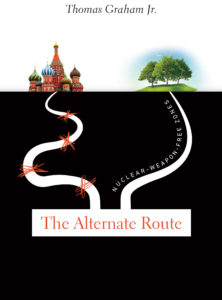 Ambassador Thomas Graham, a member of the Center’s National Advisory Board, recently published a book, The Alternate Route: Nuclear-Weapons-Free Zones.
Ambassador Thomas Graham, a member of the Center’s National Advisory Board, recently published a book, The Alternate Route: Nuclear-Weapons-Free Zones.
I asked him a few questions about the book and his thoughts on the current state of global nuclear disarmament. This interview has been edited for clarity and brevity. This is the second part of a two-part interview. Read part one.
Is the alternate route the last route? The final hope for global denuclearization?
I don’t know if it’s the final one, but it’s all there is right now, probably as long as Vladimir Putin is president of Russia. Who knows what will happen in the most distant future, but for now, it is the only alternative. Some people say global zero — total disarmament — is an alternative. It’s not a realistic alternative at the present time. Not one nuclear weapon state participated in the global ban negotiations; not one has said anything nice about the ban treaty; not one nuclear weapon state has expressed anything but opposition or resistance to it, and it’s not going to get us anywhere today. Right now, the nuclear-weapons-free zones process is the best current option for progress.
What is your assessment of the current global nuclear situation and global disarmament efforts?
Well, there have been predictions that there will be a nuclear war this year, by reputable people. I think it’s very unlikely myself. I don’t think North Korea has any intention of starting such a war, but anything can happen.
There’s always been the idea that nuclear disarmament depends on initiatives from the United States, and right now there are zero initiatives from the United States; in fact, we’re going in the opposite direction. So are Russia and China. This makes for a more dangerous world situation. There is a further danger that the nuclear Non-Proliferation Treaty (NPT) regime could break down without further progress in nuclear disarmament. The cause of nuclear disarmament also is, if anything, going in reverse.
There are things that could be done; but there’s a focus on things that look good, as opposed to things that might do some good — most importantly bringing the Comprehensive Nuclear-Test-Ban Treaty (CTBT) into force, which, of course, is being blocked in the U.S. Senate. We should keep pressuring Senators to vote on the treaty, and maybe someday they will come around. We should do things that really advance the ball rather than just look good. The Test Ban brought into force would greatly strengthen the NPT. A worldwide no-first-use of nuclear weapons convention could be negotiable. Progress on a weapon-of-mass-destruction-free zone in the Middle East is vital.
What do you hope people take away from your book?
I would hope that, number one, readers will understand how truly dangerous nuclear weapons are and that the world is not safe from them. Two, I would hope that readers would realize that the NPT is a complicated document, based on negotiated arrangements with countries around the world – but is all important to peace. Three, that central to their obligations under the NPT, nuclear weapons states must pursue nuclear disarmament, and right now we can’t do that because of the U.S.-Russia relationship. So I hope readers understand what other countries have done to advance the cause of disarmament, and consider whether there is any possibility that this free-zone process could at least partially replace the U.S.-Russia process. I hope a careful look will be taken at the zones that exist, why they’re there and what they’ve accomplished, and the fact that they are the result of serious, detailed and lengthy negotiations and reflected in complicated, effective documents.
Who do you hope reads this book?
I think many people could be interested in this book, but it is especially important for scholars, students, nuclear policy experts and anyone interested in the fate of the Earth.
